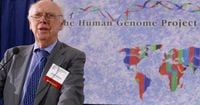The passing of James Watson, the co-discoverer of the DNA double helix, has reignited both celebration and controversy in the scientific world. Watson died last week at the age of 97, prompting tributes that hailed him as a “pioneer of genetics,” but also reopening debates about the legacy of his achievements and the overlooked contributions of Rosalind Franklin, whose work was essential to the breakthrough.
Watson’s name is inextricably linked with the discovery of the double helical structure of DNA, a finding that revolutionized biology and medicine. According to Nature and numerous obituaries published this week, his role in uncovering the shape of the molecule that encodes genetic information remains one of the defining moments in twentieth-century science. Yet, as the world reflects on his legacy, the shadow of Franklin’s omission looms large—a story of brilliance, rivalry, and the complexities of scientific credit.
Rosalind Franklin, a British chemist and expert in X-ray crystallography, provided the first clear image of DNA’s structure—famously known as “Photo 51.” This ghostly X-shaped diffraction pattern offered the decisive evidence that DNA was, in fact, a helical molecule. Franklin’s painstaking work at King’s College London laid the foundation for Watson and his collaborator, Francis Crick, to build their now-iconic model of DNA. In 1962, Watson, Crick, and Maurice Wilkins shared the Nobel Prize in Physiology or Medicine for the discovery. Franklin—who had died of cancer four years earlier—was not included, as the prize is not awarded posthumously.
Recent historical research, including a 2023 reappraisal in Nature, has upended the old narrative that cast Franklin as a mere provider of data. Instead, she is now recognized as an intellectual equal, independently converging on the helical structure of DNA through her own rigorous analysis. The research reveals that Franklin discerned DNA’s multiple conformations and understood their structural implications, bringing her to conclusions remarkably similar to those of Watson and Crick—albeit through different routes.
Yet, the path to the Nobel was marred by ethical controversy. As Felix Online reports, Franklin’s critical data—specifically Photo 51—was shown to Watson and Crick without her knowledge or consent. This unauthorized sharing of information was emblematic of the era’s scientific culture, where women’s labor was often appropriated or undervalued, and informal male networks dominated the field. In 1953, the same issue of Nature that published the now-famous Cambridge paper by Watson and Crick also featured reports by Wilkins and Franklin. Together, these papers formed the scaffolding of the DNA discovery, though only the male-authored works received widespread acclaim.
Franklin’s expertise in X-ray crystallography was often dismissed, and her ideas were excluded from the informal discussions and collaborations that propelled her male colleagues forward. She was not merely an unwitting victim of theft, as the myth once suggested, but a collaborator whose contributions were systematically marginalized. Watson’s later memoir, The Double Helix, further distorted her legacy by referring to her condescendingly as “Rosy” and portraying her as obstructive and obtuse—a characterization many historians now regard as both patronizing and historically dishonest.
Despite battling cancer, Franklin continued to publish and lead research until her untimely death in 1958, at just 37 years old. The Nobel Prize, awarded four years later, went solely to her male peers. While the scientific community has made efforts to restore Franklin’s name to its rightful place in the narrative, these posthumous recognitions feel, as Felix Online notes, like an uneasy act of conscience rather than true justice. Her story is a stark reminder of the many women in science whose work has been overlooked, the full impact of which may never be known.
Watson’s own legacy is complicated not only by the ethical questions surrounding the DNA discovery but also by his later public statements. As recounted by Fintan Steele, a former Benedictine monk and Ph.D. in biology, Watson was a towering figure in molecular biology and served as Director at Cold Spring Harbor Laboratory on Long Island. Steele, who met Watson during a summer course in 1988, remembers him as a charismatic and gracious leader in person. However, he also notes that Watson “had several far less gracious moments in his life,” many of which have been highlighted in recent obituaries. Watson made numerous public statements that suggested “serious streaks of misogyny, racism and homophobia,” though he often insisted he was misunderstood or misquoted.
These lamentable incidents, Steele argues, “dethrone him as an idol” but do not negate the significance of his scientific contributions. The discovery of the double helix was a milestone, but as Steele points out, neither the structure-solvers nor DNA itself live up to their sometimes mythic reputations. The double helix is often seen as an icon—even inspiring products like cologne bottles shaped in its image—but the reality of genetics is far more complex.
DNA, despite being dubbed the “Book of Life” or the “Secret of Life” by Watson and others, is not a comprehensive instruction manual for making a human being. “Your genome is more like an IKEA parts list with incomplete, missing, or undecipherable assembly instructions,” Steele writes. The popular notion that genes are destiny—a belief exploited by companies selling direct-to-consumer DNA tests—is categorically false. While certain mutations can increase the risk of specific diseases, the interplay of genes with each other and with environmental factors is far more intricate than a simple cause-and-effect relationship.
This misunderstanding has led, in some circles, to dangerous ideas about genetic determinism and even the notion of a genetically “superior” race. Such interpretations are not only scientifically inaccurate but have been used to justify exclusion and prejudice. “What matters most here are not the individual genes and their variations (mutations), but how all of them interact in increasingly intricate networks and circuits, both with each other and with the environmental factors pressing in on us from all sides,” Steele argues.
Solving the structure of DNA was, ultimately, just a first glimpse into the bewildering complexity of biology—a moment when imperfect humans discovered something fundamental about life, but not the whole story. The event and its individuals are worth noting, but not exalting uncritically. As the scientific community reflects on the intertwined legacies of Watson, Crick, and Franklin, it’s clear that the story of DNA is as much about the pursuit of truth as it is about the messy, often unjust, realities of human endeavor.
Franklin’s inspiring yet tragic story continues to resonate as a cautionary tale for science and society. As we remember Watson and his peers, the imperative remains: to honor not only the discoveries but also the discoverers—and to ensure that history remembers all those whose brilliance shaped our understanding of life itself.




